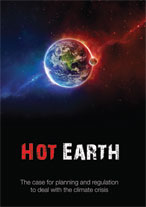Climate change
Smoke fallout
Breathing smoke from bushfires and burn-offs is deadly for humans and animals. Recent smoke haze over Sydney on May 21, will cause considerably more illnesses than authorities have stated.

The NSW state government issued a health warning. The EPA labelled the quality “poor” and warned people with health issues to stay indoors. NSW Health’s environmental health director Richard Broome gave scant warnings; he reportedly said “smoke could irritate the respiratory system and aggravate existing lung and heart conditions”, and that “for most people, smoke will be no more than an irritation”.
These statements from authorities are only part of the facts, important health effects from breathing smoke from bushfires, burn-offs are numerous.
Both federal and state governments accept fire smoke inhalation as a cause of cancers.
The Commonwealth amended firefighting legislation in Australia in 2011, and state governments have since legislated for bushfire volunteers to receive compensation after a qualifying period. Researchers on cancers have identified the general time lag between the beginning of the bushfire smoke and the inhalation and the development into cancer.
The legislated list shows some short period before the expectation of cancer development.
Wood smoke contains particles so small that, when inhaled, they can cross the lung lining and end up in the blood stream. Wood smoke also contains other chemicals that can affect our health. The health problems associated with wood smoke include asthma, chronic lung disease, heart problems and premature births and deaths. Some of the toxic chemicals in wood smoke are known to cause cancer.
The air shed over Sydney is already polluted with carcinogenic air pollution from industry polluters, heavy diesel cars and truck traffic, diesel locomotives, diesel ships and unregulated off-road diesel and petrol motors: the winter months will bring more toxic air pollution from domestic wood heaters.
Cyanide in part of wood smoke
The most common occurrence of cyanide poisoning is when persons admitted to hospital due to fire accidents may have been exposed to carbon monoxide (CO) as well as cyanide (CN). It has been reported that the most common source of CN poisoning in humans arises from exposure to fires. In fires cyanide is developed when the temperature reaches 315ᵒC and is released from toxic fumes in the gaseous form, i.e. hydrogen cyanide (HCN) which may then be inhaled by the victim.
HCN is developed from an incomplete combustion of any material containing nitrogen such as plastic, vinyl, wool or silk. It is worth noticing that when cotton burns it develops 130 µg HCN/g, (1 microgram is equal to one millionth of a gram). Paper 1,100 µg HCN/g and wool 6300 µg HCN/g. Be aware that HCN is still produced when the fire is only glowing embers.
(Source: Laurence Smith et al Scandinavian Journal of Trauma Resuscitation and emergency Medicine, 2011.)
CSIRO confirms health risks
The CSIRO also confirmed the health risks stating epidemiological studies have concluded that there is a statistically significant relationship between fine particles and human health effects, such as decreased lung function, increased respiratory symptoms, increased chronic obstructive pulmonary disease, increased cardiovascular and cardiopulmonary disease, and increased mortality. Recent research has identified a strong link between PM2.5 (particulate matter 2.5 microns) and life expectancy).
PM2.5 is believed to be the most health-hazardous air pollutant, responsible for 10 to 20 times as many premature deaths as the next worst pollutant, ozone. Just as “every cigarette is doing you damage”, every gram of wood smoke or other particle emissions is also causing health problems. The estimated health costs of a kg of PM2.5 emissions in Sydney is more than $235. Source: Home Parliamentary Business Committees Senate Standing Committees on Community Affairs Completed Inquiries and reports Completed Inquiries, Chapter 2, Particulate matter sources and effects. 2010-13.
Particulate deaths
Bushfires, factory fires and house fires give off huge amounts of particulates PM10 (particulate matter 10 or less micrometres) (PM2.5 particulate matter PM2.5 or less micrometres). The World Health Organisation (WHO), specialised cancer agency, the International Agency for Research on Cancer (IARC), in 17/10/2013 announced it has classified outdoor air pollution and one of its major components particulate matter PM, as carcinogenic to human beings.
The IARC also noted a positive association between such pollution and an increased risk of bladder cancer. Evidence published by WHO earlier in 2013 confirmed and strengthened the causal link between fine particulates PM2.5 and cardiovascular and respiratory ill health. It also showed that long-term exposure to PM2.5 can trigger a range of problems, such as atherosclerosis, adverse birth outcomes and childhood respiratory diseases, and suggested possible links with neurological development, cognitive function and diabetes.
Sharing resources?
We have a limited number of water bombers in Australia. The big challenge for their use in multiple bushfire situations generally is when states are battling fires at the same time as others states. The number of large water bombing aircraft are urgently needed to extinguish fires as quickly as possible to reduce toxic air. Water bombers have proven their worth numerous times in containing bushfires.
The National Aerial Firefighting Centre (NAFC) was formed by the states and territories in 2003 to combat bushfires.
This national aircraft fleet receives funding support from the Australian government as well as state and territory governments. The responsibility for suppressing bushfires rests with each state and territory. Most firefighting aircraft are chartered from commercial aircraft service providers, and a small number of aircraft are owned and operated by Australian fire agencies.
All essential services including water bombing aircraft should be owned and operated by the government and not be for private companies to make vast profits at taxpayer’s expense. Many people now recognise that they have been betrayed by state and federal government’s drives to privatise and outsource essential services for short term gain, to so-call balance the budget.
People have a right to know the scientific health facts about toxic smoke and health outcomes from breathing in smoke from bushfires, burn-offs, factories, buildings, and house fires, and not be treated like mushrooms, like they have been by state governments and their Departments of Health and Environment Protection Authorities.













